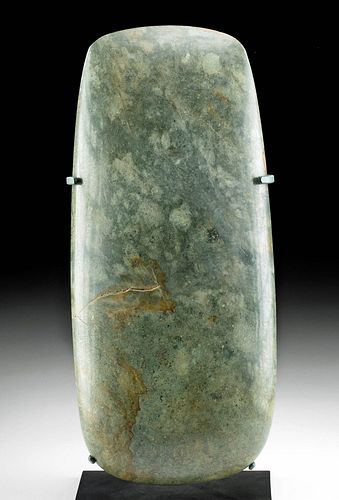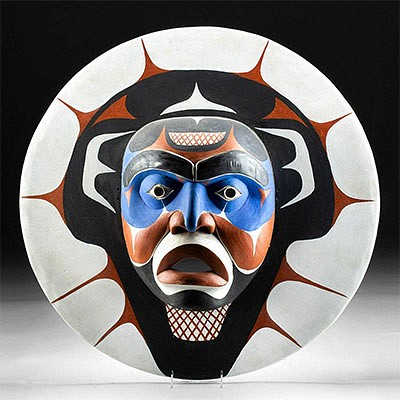Huge / Important Olmec Green Jadeite Celt
Lot 8a
About Seller
Artemis Fine Arts
686 S Taylor Ave, Ste 106
Louisville, CO 80027
United States
Selling antiquities, ancient and ethnographic art online since 1993, Artemis Gallery specializes in Classical Antiquities (Egyptian, Greek, Roman, Near Eastern), Asian, Pre-Columbian, African / Tribal / Oceanographic art. Our extensive inventory includes pottery, stone, metal, wood, glass and textil...Read more
Categories
Estimate:
$4,000 - $6,000
Absentee vs Live bid
Two ways to bid:
- Leave a max absentee bid and the platform will bid on your behalf up to your maximum bid during the live auction.
- Bid live during the auction and your bids will be submitted real-time to the auctioneer.
Bid Increments
| Price | Bid Increment |
|---|---|
| $0 | $25 |
| $300 | $50 |
| $1,000 | $100 |
| $2,000 | $250 |
| $5,000 | $500 |
| $10,000 | $1,000 |
| $20,000 | $2,500 |
| $50,000 | $5,000 |
| $100,000 | $10,000 |
| $200,000 | $20,000 |
About Auction
By Artemis Fine Arts
Mar 18, 2021
Set Reminder
2021-03-18 10:00:00
2021-03-18 10:00:00
America/New_York
Bidsquare
Bidsquare : Pre-Columbian | Tribal | Oceanic
https://www.bidsquare.com/auctions/artemis-gallery/pre-columbian-tribal-oceanic-6520
Featuring Pre-Columbian, Native American, African / Tribal, Oceanic, much more. All items have been legally acquired and are legal to sell. Convenient in-house shipping. Artemis Fine Arts info@artemisfinearts.com
Featuring Pre-Columbian, Native American, African / Tribal, Oceanic, much more. All items have been legally acquired and are legal to sell. Convenient in-house shipping. Artemis Fine Arts info@artemisfinearts.com
- Lot Description
Pre-Columbian, Southern Mexico to Guatemala, Olmec, ca. 1500 BCE. COLOSSAL, MONUMENTAL, ENORMOUS, a ceremonial jadeite celt (axe), skillfully hand-carved from blue-green jadeite with mottled sage green inclusions. The jadeite was meticulously flaked and then sanded smooth to a reflective sheen, resulting in a tool with an elegant, tapering body presenting a rounded handle and a broad upper section with an acutely-angled edge. A highly-stylized ritual form for ceremonial and/or funerary purposes, this Olmec jade celt exemplifies the arduous technique of ancient stone-shaping as well as Olmec's artistry. Size: 5.9" W x 13.5" H (15 cm x 34.3 cm); 14.5" H (36.8 cm) on included custom stand.
Celts were associated with ears of corn, the V-shape being associated with the husk from which the cob emerged. At La Venta (a coastal city near present day Tabasco), caches of celts were discovered planted vertically like miniature stelae. The blunt end of this celt would suggest a similar use, and when placed in a vertical position its appearance is much more dramatic. In this stance the celt served to define the central axis mundi and the corners of the four-sided world, regarded as a cosmic maize field.
Research in the late 1990s and early 2000s pinpointed the source of what is colloquially referred to as "Olmec blue" jade in the lowland Motagua River near the modern-day border of Guatemala and Honduras; stone from this source was carved and traded widely throughout early Mesoamerica. The value of jade for ancient people lay in its symbolic power: perhaps its color was associated with water and vegetation; later, the Maya would place jade beads in the mouths of the dead. Many scholars have argued that the demand for jade contributed to the rise of long-distance trading networks and to the rise of urban centers in ancient Mesoamerica. This jade celt would have been regarded as an exceedingly valuable and rare piece of ceremonial art.
See similar Olmec jade celts in the collection of the National Archaeological Museum in Mexico City.
Provenance: private Hawaii, USA collection; ex-Ian Arundel collection, California, USA, the Old Curiosity Cabinet, Melrose Ave., Los Angeles, California, USA, collected 1950-1970
All items legal to buy/sell under U.S. Statute covering cultural patrimony Code 2600, CHAPTER 14, and are guaranteed to be as described or your money back.
A Certificate of Authenticity will accompany all winning bids.
We ship worldwide and handle all shipping in-house for your convenience.
#157056Professionally repaired from multiple large pieces, with restoration to large swath on obverse across upper half, and resurfacing with overpainting along new material and break lines. Light abrasions and nicks to body, butt end, and blade edge. Nice surface smoothness throughout. Old inventory label on verso.Condition
- Shipping Info
-
All shipping is handled in-house for your convenience. Your invoice from Artemis Gallery will include shipping calculation instructions. If in doubt, please inquire BEFORE bidding for estimated shipping costs for individual items.
-
- Buyer's Premium



 EUR
EUR CAD
CAD AUD
AUD GBP
GBP MXN
MXN HKD
HKD CNY
CNY MYR
MYR SEK
SEK SGD
SGD CHF
CHF THB
THB














